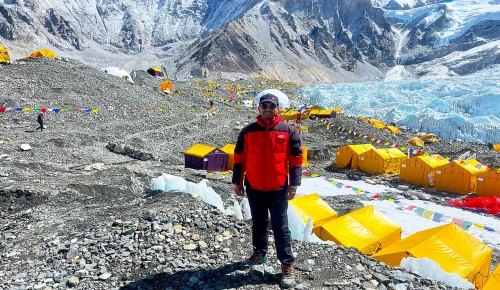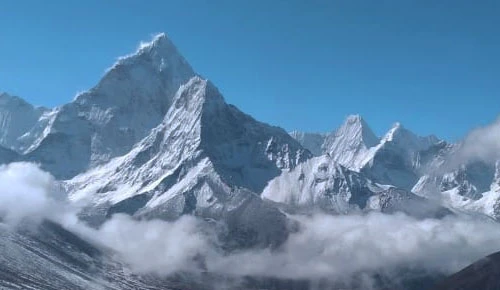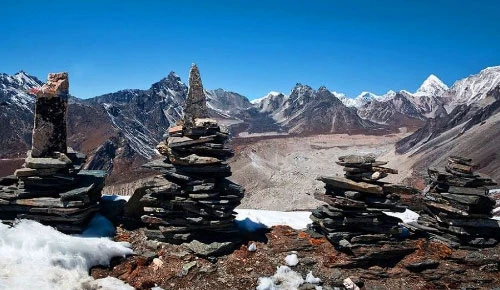Everest Base Camp Trek Difficulty
Picture yourself standing at the foot of the majestic Himalayas, ready for an incredible trekking adventure to Everest base camp. This thrilling journey lasts for 14 days and offers breathtaking scenery and unforgettable moments. Starting from the lively city of Kathmandu, you'll travel through charming villages, lush forests, and exciting suspension bridges. Every day will bring new wonders, such as stunning waterfalls and snowy mountain peaks. The trek is carefully planned to help your body adjust to the high altitude, ensuring your safety and enjoyment.
Along the way, you'll have the chance to experience the warm hospitality of the Sherpa people, visit ancient monasteries, and truly immerse yourself in their fascinating culture. Finally, after days of perseverance, you'll reach the legendary base camp, standing proudly beneath the world's tallest mountain. This moment will leave you in awe—a testament to your strength and the breathtaking beauty of nature. This trek is an extraordinary adventure that will fill your heart with a sense of accomplishment and a profound connection with the awe-inspiring Himalayas.

Everest base camp trek is considered to be moderately difficult, requiring a good level of physical fitness and mental preparation. The main challenge lies in the high altitude and rugged terrain. As you ascend, the air becomes thinner, making breathing harder and increasing the risk of altitude sickness. Acclimatization is crucial to allow your body to adjust to the altitude gradually. This trek involves walking for several hours each day, often on steep and rocky paths. You'll need to carry a backpack with essential items, which can add to the physical strain.
However, with proper training, preparation, and a positive mindset, this trek is achievable for many adventure enthusiasts. It's important to listen to your body, take breaks when needed, and follow the guidance of experienced guides or Sherpas to ensure a safe and enjoyable journey to the base camp of the world's highest peak.
Table of Contents
Physical Fitness Requirements
Picture this: You're standing at the foot of the mighty Mount Everest, ready to embark on an extraordinary adventure. But before you lace up your boots and hit the trail, it's important to understand the physical fitness requirements. This journey demands more than just a casual stroll in the park. You'll be conquering rugged terrain, ascending steep slopes, and overcoming altitude challenges. Your body needs to be prepared for this remarkable feat.
Building your endurance, strength, and cardiovascular fitness is crucial. Engage in regular exercises like hiking, jogging, and cycling to condition your muscles and improve your stamina. Don't forget about core exercises to stabilize your body and keep you balanced on uneven paths. Remember, the fitter you are, the more you'll be able to relish the breathtaking vistas and conquer this trek to Everest base camp with confidence and determination.
Altitude Sickness and Acclimatization
Altitude sickness is a condition that can affect people when they travel to high-altitude areas like the Everest base camp. It occurs due to the reduced amount of oxygen in the air at higher elevations. When you ascend too quickly, your body may struggle to adjust to the change in altitude, leading to symptoms such as headaches, dizziness, nausea, and fatigue. Acclimatization is the process of allowing your body to adapt gradually to the higher altitude and lower oxygen levels.
It involves taking regular rest days, drinking plenty of fluids, and ascending slowly to give your body time to adjust. Acclimatization is crucial for a successful trek to Everest base camp, as it helps minimize the risk of altitude sickness and ensures your body can cope with the demanding conditions. It's important to listen to your body, follow the advice of experienced guides, and take the necessary precautions to acclimatize properly during the trek.
Trekking Season and Weather Conditions
Trekking in the Everest area requires careful consideration of the trekking season and weather conditions. The weather plays a crucial role in determining the difficulty level of the trek and your overall experience. Generally, the best time to undertake the Everest base camp trek is during the pre-monsoon (spring) and post-monsoon (autumn) seasons.
During these periods, the weather is relatively stable, and the skies are clear, offering breathtaking views of the mountains. Spring (March to May) brings warmer temperatures and blooming rhododendron forests, while autumn (September to November) offers cool and dry weather with excellent visibility.
However, it's important to be prepared for sudden weather changes, even during these favorable seasons. The Khumbu region is known for its unpredictable mountain weather, which can bring about sudden storms, heavy snowfall, or strong winds. It's essential to stay updated with weather forecasts and be equipped with appropriate clothing and gear to tackle any unexpected weather conditions.
Recommended Training and Preparation Plan
Preparing for trekking requires physical fitness and proper training to ensure a safe and enjoyable journey. Here is a recommended training and preparation plan to get you ready for the challenges ahead:
Cardiovascular Fitness: Start by improving your cardiovascular endurance through activities like jogging, cycling, swimming, or brisk walking. Aim for at least 30 minutes of aerobic exercise, three to four times a week. Gradually increase the duration and intensity of your workouts to build stamina.
Strength Training: Include strength training exercises to strengthen your leg muscles, core, and upper body. Squats, lunges, step-ups, and planks are effective exercises to target these areas. Consider using weights or resistance bands for added intensity. Aim for two to three strength training sessions per week.
Hiking and Walking: Since the Everest base camp hike involves long hours of walking, it's important to condition your body for sustained walking over uneven terrain. Gradually increase the duration and intensity of your hikes, incorporating uphill and downhill sections. Start with shorter hikes and gradually progress to longer distances.
Stair Climbing: As the trek involves numerous uphill sections, climbing stairs can simulate the conditions you'll encounter. Incorporate stair climbing into your training regimen by using stairs instead of elevators whenever possible. You can also try using a stair climber machine at the gym.
Endurance Training: To build endurance, consider undertaking longer hikes or multi-day hikes on weekends or during vacations. This will help your body adapt to prolonged physical exertion and walking for several consecutive days.
Backpack Training: Get accustomed to carrying a backpack by gradually increasing the weight you carry during your training hikes. Start with a lighter load and gradually add weight until you can comfortably carry the weight you plan to take on the trek. This will help your body adjust to the additional strain on your back and shoulders.
Altitude Training: If possible, consider incorporating altitude training into your preparation. This can involve hiking or training at high altitudes to help your body adapt to lower oxygen levels. However, it's important to consult with a healthcare professional before attempting altitude training.
Mental Preparation: Apart from physical training, prepare yourself mentally for the challenges you may face during the trek. Research the trek thoroughly, understand the risks involved, and set realistic expectations. Stay positive, motivated, and mentally resilient throughout the journey.
Consult with Professionals: If you're new to trekking or unsure about your training plan, consider seeking advice from fitness trainers or trekking experts. They can provide personalized guidance based on your fitness level and help you create a training plan that suits your needs.
Remember to listen to your body during training and gradually increase the intensity and duration of your workouts. Stay hydrated, maintain a balanced diet, and get sufficient rest to aid in recovery. With proper training and preparation, you'll be well-prepared to tackle the Everest base camp climbing and create lasting memories of this incredible adventure.
Length and Duration of the Trek
The length and duration of the trek can vary depending on the route and individual preferences. On average, the trek covers a distance of approximately 65 kilometers (40 miles) one way, starting from Lukla and ending at base camp. The trek usually takes about 12 to 14 days to complete, allowing for proper acclimatization and enjoyment of the stunning Himalayan scenery along the way. Each day, you'll typically hike for around 5 to 7 hours, covering varying distances and terrain.
It's important to remember that the trek is not a race; it's a journey that allows you to immerse yourself in the beauty of the Khumbu region and take in the breathtaking sights at your own pace. The length and duration of the climb may seem challenging to some, but it is designed to provide trekkers with enough time to acclimatize to the high altitude. The slow and steady pace allows your body to gradually adjust to the decreasing oxygen levels as you ascend.
This helps reduce the risk of altitude sickness and ensures a safer and more enjoyable experience. It's worth noting that the trek can be customized to fit your preferences and fitness level. Some trekkers choose to extend the duration by including side trips or rest days at certain points along the route. Remember, the focus is not just on reaching the base camp but also on savoring the incredible landscapes, interacting with the local Sherpa culture, and creating lasting memories in the heart of the Himalayas.
Daily Trekking Distances and Elevations
When it comes to the daily trekking distances and elevations during the trekking to base camp of Everest, it's important to be prepared for a challenging yet rewarding journey. Each day, you'll be covering a certain distance on foot, which can vary depending on the specific itinerary you choose. The terrain you'll encounter ranges from rocky paths to steep ascents and descents, so it's essential to have a good level of fitness.
Moreover, as you ascend higher into the majestic Himalayas, you'll be gaining elevation, and this gradual increase in altitude presents its own set of challenges. It's crucial to take it slow, allowing your body to acclimatize to the changing altitude and ensuring a safer and more enjoyable trekking experience. So, be ready to embrace the adventure and marvel at the breathtaking landscapes while taking care of yourself along the way.
Terrain and Trail Conditions
Terrain and trail conditions play a crucial role in determining the difficulty level of trekking to Everest. The trek takes you through a variety of terrains, ranging from gentle slopes to steep ascents and descents. You'll encounter rocky paths, uneven trails, and sections with loose gravel. The terrain can be challenging at times, requiring careful footing and balance. Additionally, there are suspension bridges to cross over deep gorges and narrow paths carved into mountainsides.
The trail conditions vary depending on the season and weather, with sections prone to mud and slippery surfaces during monsoon season. It's important to be prepared for these conditions and have appropriate footwear and trekking poles to navigate the terrain safely. Despite the challenges, the awe-inspiring landscapes and the sense of achievement make it all worthwhile.
Challenges and Risks of the Trek
Trekking presents its fair share of challenges and risks, even for experienced adventurers. One of the primary challenges is the high altitude, which can lead to acute mountain sickness (AMS) if not properly acclimatized. The thin air at higher elevations makes breathing more difficult, and symptoms like headaches, nausea, and fatigue can occur. Additionally, the rugged terrain and steep ascents and descents pose physical challenges, demanding endurance and stamina.
Extreme weather conditions, including unpredictable snowstorms and high winds, can also add to the risks. Moreover, the remoteness of the region means limited access to medical facilities and emergency services. Therefore, it is essential to be well-prepared, physically fit, and take necessary precautions to mitigate these challenges and ensure a safe and enjoyable trekking experience.
Tips for a Successful and Enjoyable Trek
Here are some tips for a successful and enjoyable trekking:
Start training and preparing in advance: Climbing the base camp of Mount Everest is physically demanding, so it's essential to start training and building up your fitness levels well before the trek. Focus on cardiovascular exercises, strength training, and hiking to prepare your body for the challenges ahead.
Pack smart and light: When it comes to packing for the trek, remember that less is more. Pack only the essentials and try to keep your backpack as light as possible. Don't forget to include proper trekking gear, comfortable clothing, sturdy footwear, and essential items like sunscreen, insect repellent, and a good-quality sleeping bag.
Take it slow and pace yourself: Trekking to higher altitudes requires acclimatization, so it's crucial to take it slow and pace yourself along the way. Avoid rushing and listen to your body. Take regular breaks, hydrate well, and allow your body to adjust to the increasing altitude gradually.
Stay hydrated and eat well: Proper hydration and nutrition are vital during the trek. Drink plenty of water to stay hydrated, even if you don't feel thirsty. Carry water purification tablets or a water filter to refill your water bottles from local sources. Eat nutritious meals that provide energy, such as carbohydrates and protein-rich foods. Local dishes like dal bhat (rice and lentils) are popular choices.
Listen to your guide and follow safety guidelines: Hiring a knowledgeable guide is highly recommended for trekking. They have experience and expertise in the region and can provide valuable insights. Follow their instructions regarding safety precautions, altitude sickness, and the best practices for trekking in the area.
Respect the local culture and environment: The Khumbu region is home to the Sherpa community, known for their rich culture and traditions. Show respect for their customs, beliefs, and the fragile environment. Be mindful of the "leave no trace" principles, dispose of waste properly, and avoid damaging the natural surroundings.
Take care of your personal well-being: Pay attention to your physical and mental well-being throughout the trek. Protect yourself from the sun by wearing sunscreen and a hat. Take breaks to rest and relax. Enjoy the breathtaking scenery and embrace the experience. Don't hesitate to share your feelings or concerns with your fellow trekkers or your guide.
Capture memories but stay present: The trekking offers incredible photo opportunities at every step, but remember to also soak in the experience without being overly focused on capturing the perfect shot. Take some time to disconnect from technology and enjoy the natural beauty surrounding you.
Be prepared for changes in weather and conditions: The weather in the Himalayas can be unpredictable, so be prepared for changes. Carry appropriate clothing layers to adapt to varying temperatures. Keep rain gear handy, and be prepared for challenging weather conditions.
Enjoy the journey and celebrate your achievements: Finally, remember to enjoy the journey and celebrate your achievements along the way. the trip is a remarkable adventure that will test your limits and leave you with unforgettable memories. Take the time to appreciate the stunning landscapes, the camaraderie of fellow trekkers, and the sense of accomplishment when you reach your destination.
By following these tips, you can enhance your chances of having a successful and enjoyable trekking adventure in Khumbu region.








